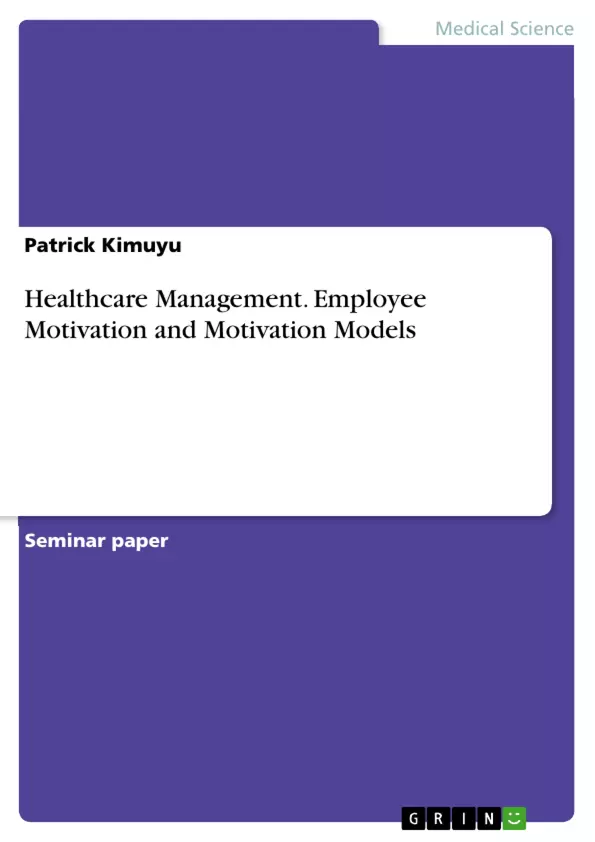Human beings have brains which respond to various signals in different manners. The nature of the attitude and the ambient environment serve as the principal determinants of an individual appropriate response. Motivation which entails that aspect of acquiring positive attitudes in the surrounding environment and incorporating them into one’s behavior, purposely aimed at enhancing performance. Consequently, a motivational behavior appear to be the only influential aspect of human nature that holds promise to realization of one’s intended goals in life as an individual.
From the work performance perspective, motivation has been known to be a basic tool for improving productivity at the workplace. For this reason therefore, it is important to nature precepts of motivational behavior for profitable output to be realized. In life, individual’s strive towards attaining success at last at the end of all tasks that one commits himself/herself ton undertake. On the hand, it is observed that all organizations’ main objective is to achieve success. It’s absolutely true to assert that all these adorable rewards from any form of work cannot be realized fully if motivation is deficient. In this research paper, all aspects of motivation are going to be discussed for general understanding as well as for identifying the most appropriate ways of nurturing motivational behavior in employees for improved performance at the workplace.
At the work place, motivation plays a very fundamental role especially with regard to attitudes of the staff and their employees or rather their managers, who are primarily concerned with supervisory matters to achieve a particular task. Motivation therefore serves as the basic tool at the workplace for managers so as to ensure efficient alignment of aims, values and purpose especially among employees in any organization. Owing to human nature, motivational efforts appear to face a great challenge as each individual possesses personal preferences or attitudes which may be difficult to change or modify. As a result, it is important for managers to first identify and comprehend precisely for their employees motivational needs, after which they will take the most appropriate approaches to align their aims and values so as to improve performance hence increased chances of success.
Inhaltsverzeichnis (Table of Contents)
- Introduction
- Employee Motivation
- Motivation Models
- Specific Models of Employee Motivation
- Traditional Theory 'X' (Sigmund Freud's theory)
Zielsetzung und Themenschwerpunkte (Objectives and Key Themes)
This research paper aims to provide a comprehensive understanding of employee motivation, exploring its role in improving performance at the workplace. The paper investigates various motivational models and their implications for management practices.
- The importance of motivation in improving productivity and achieving organizational success
- The nature of intrinsic and extrinsic motivation and their influence on employee behavior
- The significance of motivational models in guiding managers to effectively motivate employees
- The strengths and limitations of various motivational models, including traditional theories and contemporary approaches
- The practical implications of motivational strategies for enhancing employee performance and satisfaction
Zusammenfassung der Kapitel (Chapter Summaries)
- Introduction: This chapter introduces the concept of motivation and its significance in both personal and professional life. It emphasizes the importance of understanding motivational behavior for achieving individual and organizational goals.
- Employee Motivation: This chapter examines the role of motivation in the workplace, focusing on how it affects employee attitudes, performance, and overall organizational success. It explores the challenges of motivating employees, considering their individual differences and preferences.
- Motivation Models: This chapter delves into the development of various motivational models by psychologists. It discusses the key elements of motivation and their applications in different work environments. The chapter also highlights the importance of feedback, autonomy, and task significance in enhancing employee motivation.
- Specific Models of Employee Motivation: This chapter presents a specific motivational model - the Traditional Theory 'X' developed by Sigmund Freud. It analyzes the assumptions and limitations of this theory, highlighting its historical relevance and contemporary criticisms.
Schlüsselwörter (Keywords)
Employee motivation, motivational models, intrinsic motivation, extrinsic motivation, workplace performance, productivity, management practices, task significance, autonomy, feedback, Sigmund Freud, Traditional Theory 'X'.
- Quote paper
- Patrick Kimuyu (Author), 2018, Healthcare Management. Employee Motivation and Motivation Models, Munich, GRIN Verlag, https://www.grin.com/document/416037



